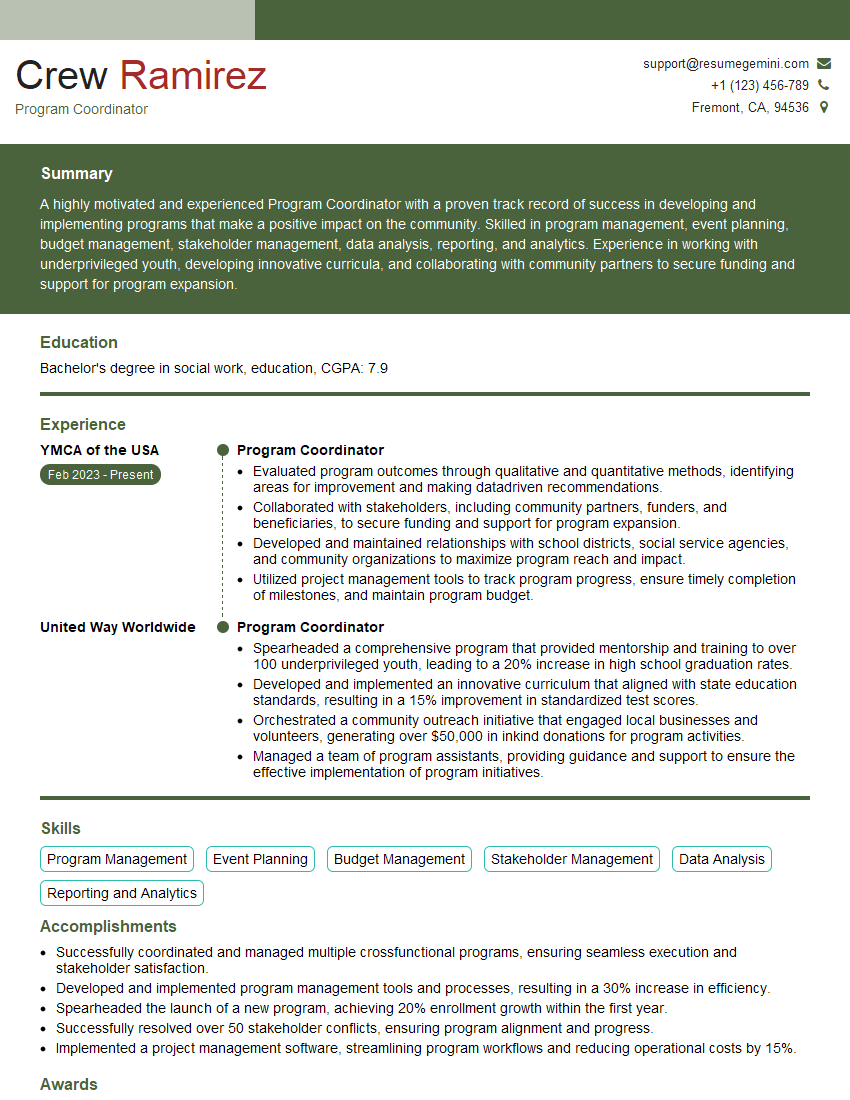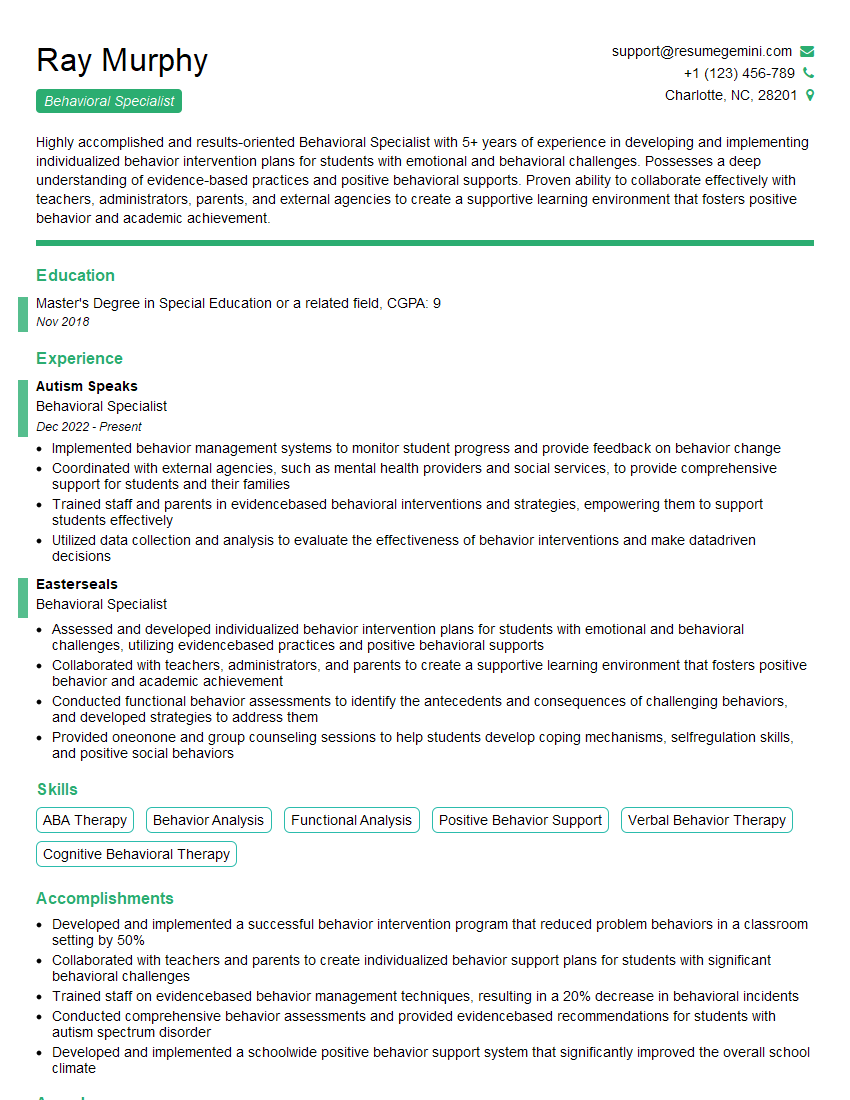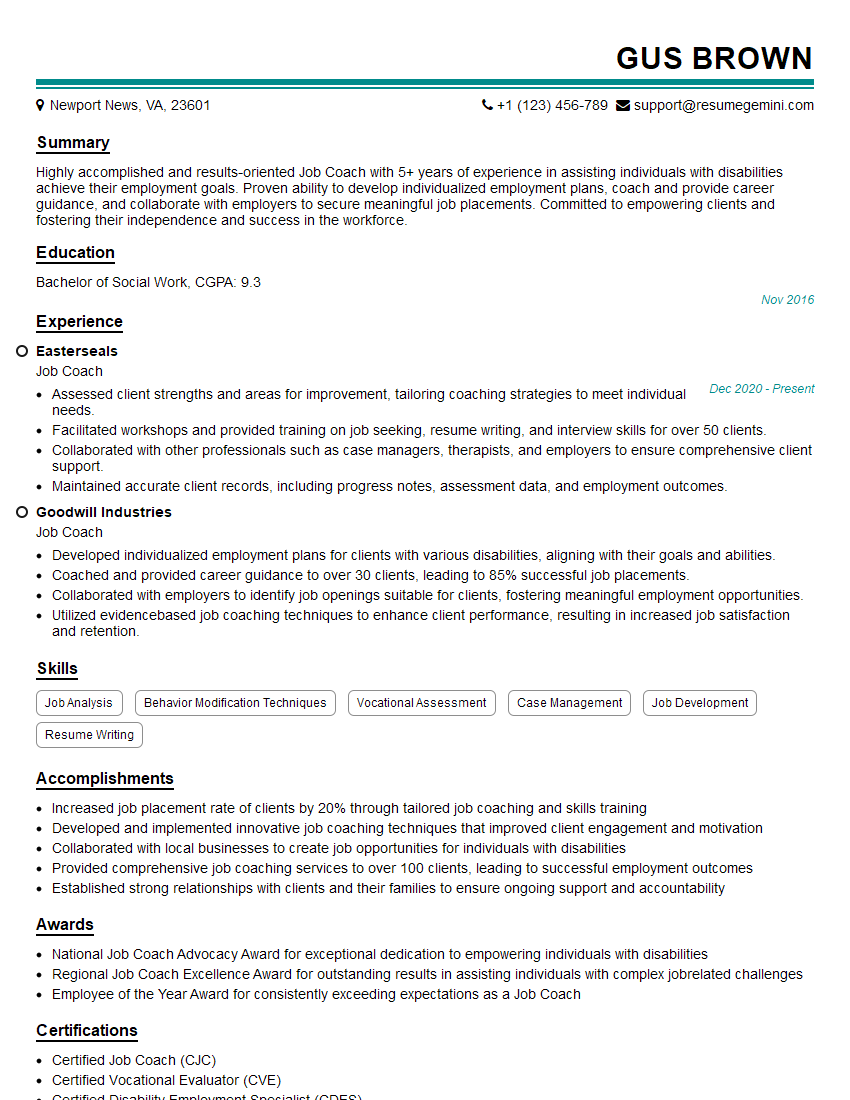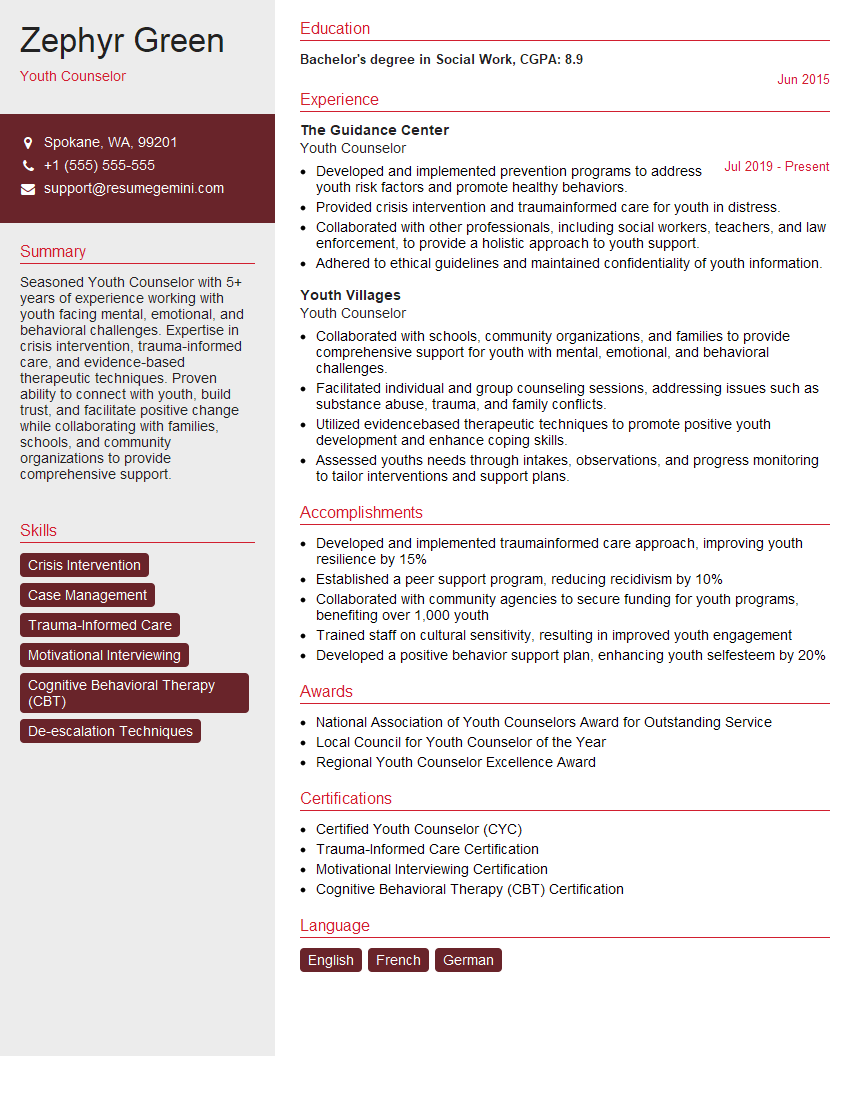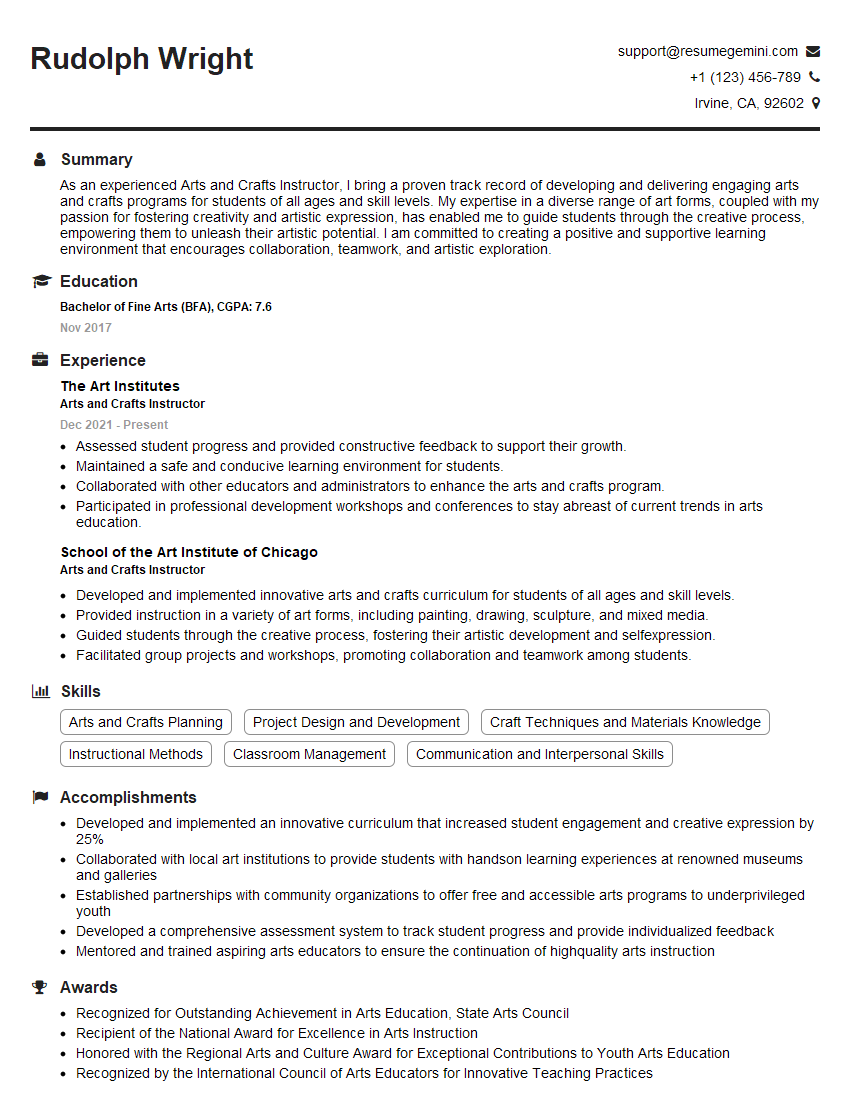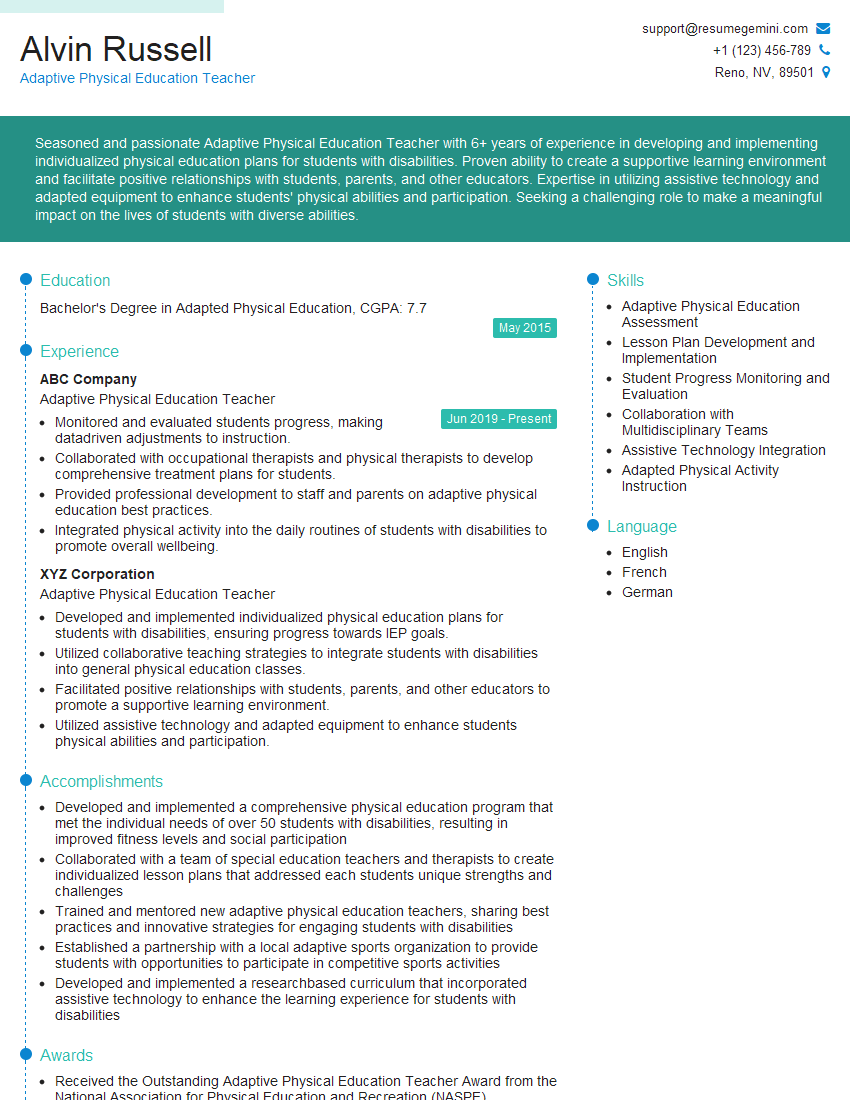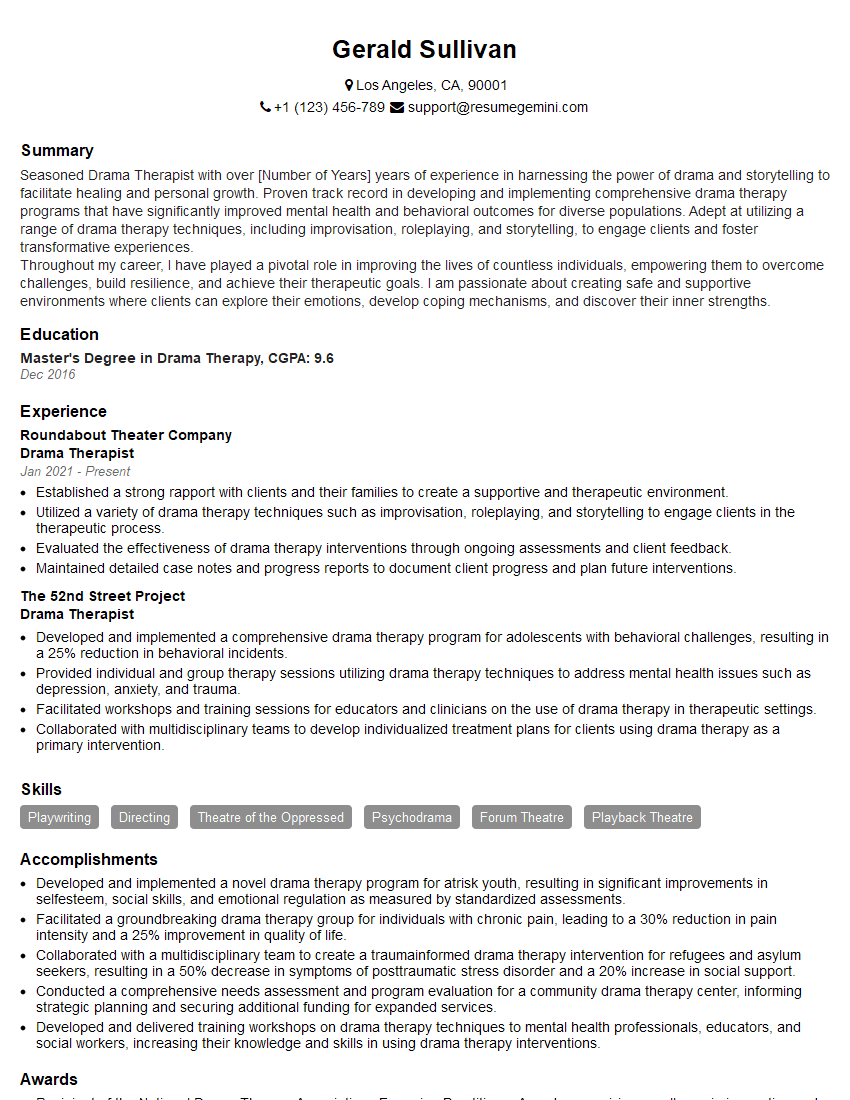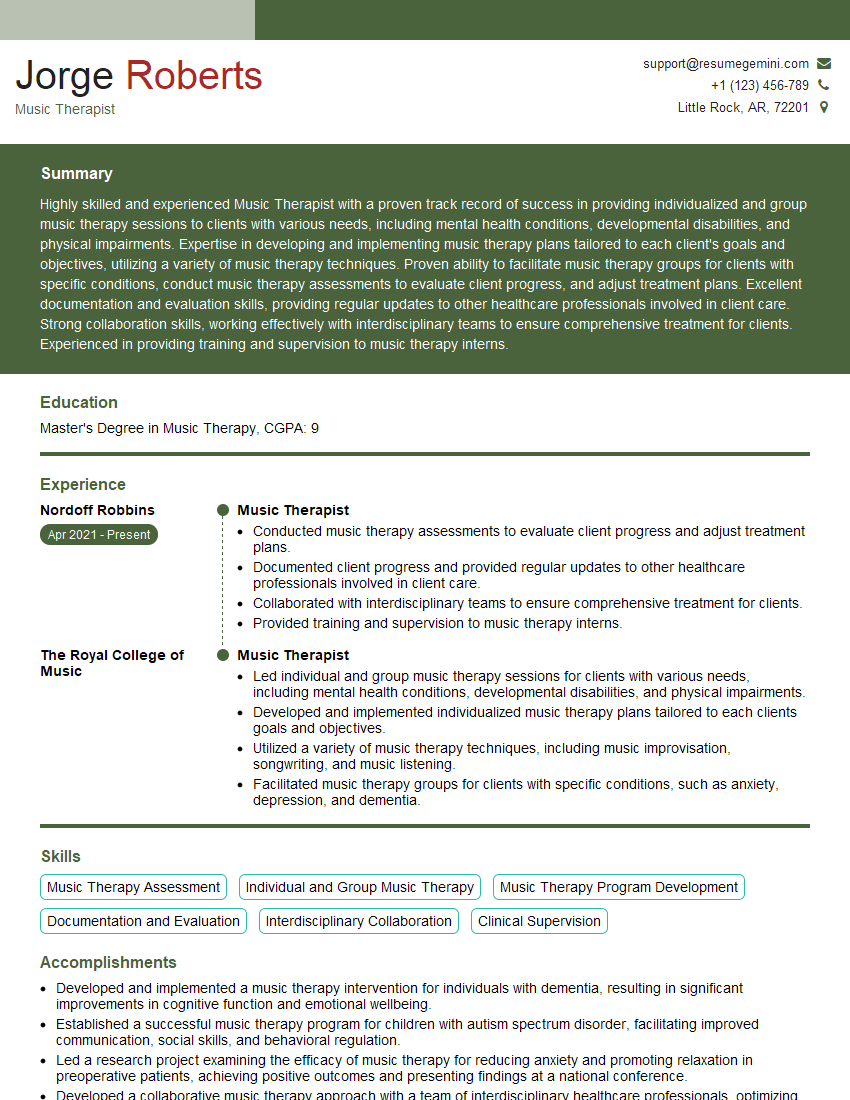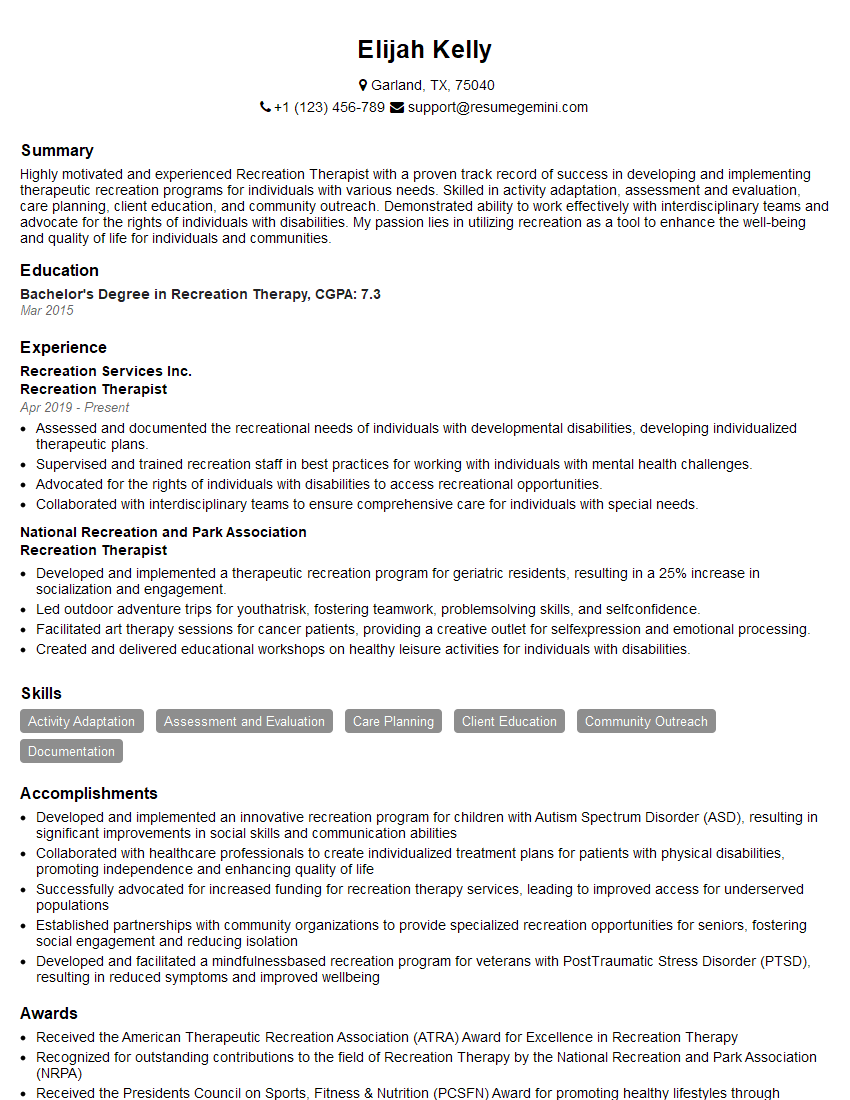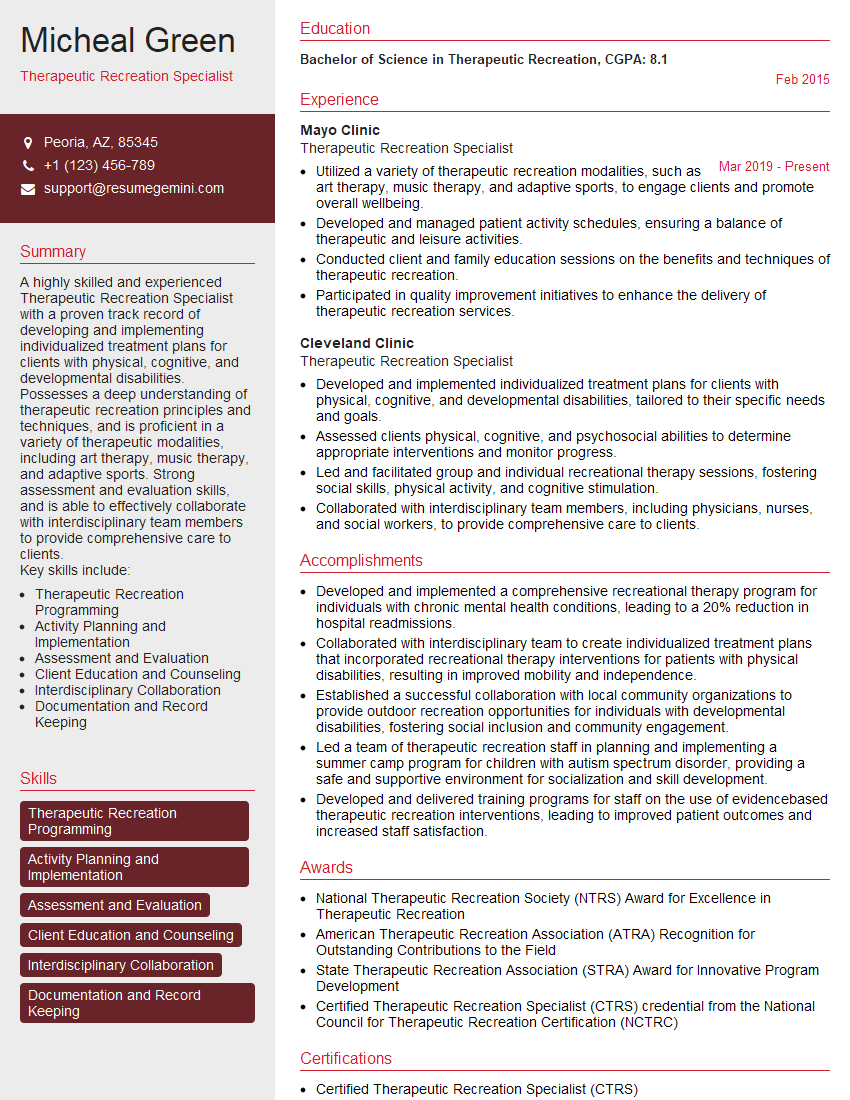Interviews are opportunities to demonstrate your expertise, and this guide is here to help you shine. Explore the essential Recreation and Leisure Skills for Students with Mental Handicaps interview questions that employers frequently ask, paired with strategies for crafting responses that set you apart from the competition.
Questions Asked in Recreation and Leisure Skills for Students with Mental Handicaps Interview
Q 1. Describe your experience adapting recreational activities for individuals with varying mental handicaps.
Adapting recreational activities for individuals with varying mental handicaps requires a deep understanding of their unique abilities and challenges. It’s not about simplifying activities, but rather modifying them to ensure engagement and success. This involves careful consideration of cognitive abilities, physical limitations, sensory sensitivities, and communication styles.
For example, a student with Down syndrome might excel at simple, repetitive tasks like sorting colored blocks, while a student with autism might benefit from structured activities with predictable routines. I’ve adapted activities like bowling by using lighter balls and ramps, modified swimming lessons with individualized flotation devices, and created adapted art projects using larger, easier-to-grasp tools. Each adaptation is tailored to the individual’s needs and preferences, prioritizing their strengths and fostering a sense of accomplishment.
In another instance, a student with ADHD struggled with focusing during traditional team sports. We modified the game by providing visual cues, breaking down instructions into smaller steps, and incorporating frequent positive reinforcement, improving both participation and enjoyment.
Q 2. How would you assess a student’s capabilities and interests to develop a personalized recreation plan?
Assessing a student’s capabilities and interests is a crucial first step in developing a personalized recreation plan. This involves a multi-faceted approach, combining observation, interviews, and assessments.
- Observation: I observe the student during various activities, noting their strengths, weaknesses, and preferred interactions. This helps identify areas of interest and potential challenges.
- Interviews: I talk to the student, their parents/guardians, and teachers to gather information about their interests, abilities, and previous experiences with recreational activities. Understanding their communication style is also vital.
- Assessments: Standardized assessments can provide objective data on cognitive function, motor skills, and sensory processing. However, these should be used in conjunction with observational and interview data, not as the sole basis for planning.
Once this information is gathered, I develop an individualized recreation plan that outlines specific activities, goals, and methods of evaluation. The plan is regularly reviewed and adjusted based on the student’s progress and changing needs. For example, a student who initially shows a strong interest in painting may later demonstrate a preference for music therapy. The plan must be flexible enough to accommodate this evolution.
Q 3. Explain your understanding of inclusive recreation practices.
Inclusive recreation practices emphasize the full participation of individuals with disabilities in recreational activities alongside their non-disabled peers. It’s about creating an environment where everyone feels welcome, valued, and supported. This isn’t just about physical accessibility; it also involves creating a sense of belonging and ensuring that activities are meaningful and enjoyable for all.
Key aspects of inclusive recreation include:
- Universal design: Designing activities and spaces that are accessible and usable by everyone, regardless of ability.
- Adaptive equipment: Providing specialized equipment or modifying existing equipment to meet individual needs.
- Peer support: Encouraging interactions between students with and without disabilities.
- Positive attitudes and respectful communication: Fostering a supportive environment that promotes inclusion and understanding.
For example, instead of separating students with disabilities into a separate group for swimming, I would incorporate adaptive techniques and support within the main swimming class to create a truly inclusive experience.
Q 4. What strategies do you employ to ensure the safety and well-being of students during recreational activities?
Ensuring the safety and well-being of students during recreational activities is paramount. My strategies include:
- Risk assessment: I conduct a thorough risk assessment before each activity, identifying potential hazards and developing strategies to mitigate them.
- Appropriate supervision: I maintain appropriate adult-to-student ratios, ensuring adequate supervision tailored to the specific activity and the students’ needs.
- Emergency preparedness: I have a well-defined emergency plan in place, including procedures for handling injuries, medical emergencies, and behavioral crises.
- Clear communication: I communicate clear expectations and rules to the students before each activity and provide consistent feedback.
- Adaptive modifications: Activities are modified as needed to ensure safety and participation for all. This might include using safer equipment, adjusting activity difficulty, or providing extra support.
For example, before a hiking trip, we would assess the trail for hazards, ensure students have appropriate footwear and hydration, and establish clear communication protocols for reporting any issues or fatigue.
Q 5. How would you handle a behavioral challenge during a group recreation session?
Handling behavioral challenges requires a calm, consistent, and individualized approach. It’s vital to understand the underlying cause of the behavior before responding. This might involve seeking input from the student’s therapists or educators.
My strategy involves:
- Positive reinforcement: Rewarding positive behaviors to encourage desired actions.
- Redirection: Gently redirecting the student’s attention to a more appropriate activity or task.
- De-escalation techniques: Using calm language and body language to help reduce the student’s stress and anxiety.
- Environmental modifications: Adjusting the environment to minimize triggers or distractions.
- Consistent consequences: Implementing pre-established consequences for disruptive behavior, while ensuring fairness and consistency.
For instance, if a student becomes overwhelmed during a group game, I might offer a quiet space for them to calm down, or adjust the game rules to reduce pressure. Collaboration with the student’s support team is crucial in developing a consistent and effective behavioral management plan.
Q 6. Describe your experience working with assistive technology to enhance recreational participation.
Assistive technology plays a vital role in enhancing recreational participation for students with mental handicaps. I’ve used a range of assistive technologies, adapting them creatively to different recreational settings.
- Adaptive switches: Students with limited motor skills can use adaptive switches to operate electronic toys or games, allowing them to participate in activities they might otherwise find inaccessible.
- Augmentative and alternative communication (AAC) devices: These devices enable students with communication difficulties to express their needs and preferences during recreational activities, improving their participation and engagement.
- Computer software and apps: Specialized software and apps can provide tailored sensory stimulation, interactive learning opportunities, or customized recreational games.
For instance, a student using a wheelchair might enjoy adapted video games using joystick controls. Another student who struggles with verbal communication might utilize a picture exchange system to communicate their enjoyment or preferences during an activity.
Q 7. How do you incorporate sensory integration principles into recreational activities?
Sensory integration is the process by which the brain organizes sensory information from the body and environment. Incorporating sensory integration principles into recreational activities can significantly enhance participation and enjoyment for students with sensory processing challenges.
I use various techniques, such as:
- Providing a variety of sensory experiences: Incorporating activities that stimulate different senses, such as visual, auditory, tactile, and vestibular (balance) senses.
- Creating a calming environment: Reducing distractions and overwhelming stimuli for students who are easily overstimulated.
- Providing opportunities for sensory regulation: Allowing students to engage in self-regulating activities, such as rocking, swinging, or using weighted blankets, as needed.
- Adapting activities to meet individual sensory needs: Modifying activities to reduce sensory overload or provide additional sensory input as needed.
For example, a student with auditory sensitivities might benefit from activities in a quieter setting with reduced background noise. Another might find comfort and focus during a weighted blanket activity. Careful observation and collaboration with occupational therapists help me to create recreational experiences which are both enjoyable and therapeutically beneficial.
Q 8. Explain your experience in creating and implementing therapeutic recreation programs.
Creating and implementing therapeutic recreation programs for students with mental handicaps requires a deep understanding of their individual needs and abilities. My approach begins with a thorough assessment, identifying each student’s strengths, weaknesses, interests, and potential challenges. This informs the design of programs that are engaging, motivating, and tailored to their specific needs. For example, a student struggling with anxiety might benefit from a calming activity like gardening or gentle yoga, while a student with ADHD might thrive in a more active program like team sports with clear rules and structure. I then develop a structured program, outlining specific goals, activities, and evaluation methods. Implementation involves close monitoring and adaptation based on student response, ensuring the program remains relevant and effective.
One successful program I implemented involved a group of students with autism spectrum disorder. We focused on improving social skills and communication through a structured drama program. We started with simple role-playing exercises, gradually progressing to more complex scenes involving interactions and conflict resolution. This allowed students to practice social cues in a safe and supportive environment, resulting in measurable improvements in their communication and social interaction skills. The program’s success hinged on consistent monitoring, frequent feedback, and adjustments made based on their individual needs and progress.
Q 9. What methods do you use to document student progress in recreational activities?
Documenting student progress is crucial for evaluating the effectiveness of therapeutic recreation programs and ensuring that each student is making progress towards their individual goals. I use a multi-faceted approach, combining both quantitative and qualitative data. Quantitative data includes metrics like participation rates, skill acquisition (e.g., number of free throws made, increase in running speed), and performance improvements on standardized assessments. For example, I might track the number of times a student successfully initiates conversation during a social skills group. Qualitative data captures observations on behavioural changes, emotional responses, social interactions, and overall enjoyment. I keep detailed anecdotal records, recording specific instances of progress or challenges.
I often use a combination of progress charts, checklists, and narrative reports to communicate this information effectively. These tools provide a clear and comprehensive picture of each student’s development, allowing for informed decision-making regarding program adjustments and future planning. Regular review meetings with the multidisciplinary team ensure consistency and effective collaboration.
Q 10. How do you foster a positive and supportive environment during recreational activities?
Creating a positive and supportive environment is paramount to the success of any therapeutic recreation program. This involves establishing clear expectations and rules, fostering a sense of belonging and camaraderie amongst the students, and promoting respect and understanding. I use positive reinforcement and encouragement extensively, focusing on celebrating achievements and acknowledging effort rather than solely on outcomes. I create a safe space where students feel comfortable expressing themselves without judgment. For example, I facilitate circle time where students can share their thoughts and feelings openly, ensuring everyone feels heard and valued.
I also incorporate elements of fun and enjoyment into activities, recognizing that participation should be engaging and enjoyable. The use of humor, positive feedback and a relaxed atmosphere all contribute to a positive experience. A crucial aspect is creating a predictable and structured environment. Routine and consistency provide a sense of security for students, which can greatly improve their participation and reduce anxiety.
Q 11. What are your strategies for engaging students with diverse learning styles in recreational activities?
Students with diverse learning styles require a range of approaches to ensure they are fully engaged and challenged in recreational activities. I cater to different learning styles by providing options within activities. For instance, instead of just providing a written instruction manual for a craft project, I would also incorporate visual aids, verbal instructions, and hands-on demonstrations. A kinesthetic learner might benefit from physical activities that allow them to move and explore their environment, while a visual learner might appreciate visual aids and demonstrations. Auditory learners will respond well to verbal instructions and discussions.
I use a variety of instructional methods, incorporating visual aids, auditory cues, hands-on activities, and social interaction. I modify activities as needed to meet individual needs. For example, if a student has difficulty with fine motor skills, I will adapt the activity to use larger materials or provide assistive tools. Adaptability and flexibility are key to ensuring inclusion and success.
Q 12. How do you communicate effectively with parents/guardians about their child’s participation in recreational programs?
Effective communication with parents/guardians is essential for building trust and ensuring collaborative support. I maintain regular communication through a variety of methods, including individual meetings, phone calls, emails, and written reports. I provide parents with regular updates on their child’s progress, highlighting both achievements and challenges. I encourage open communication, inviting parents to share their observations and concerns. I ensure that all communications are clear, concise, and tailored to the parents’ understanding, avoiding overly technical jargon.
I proactively share information about the program’s goals, activities, and assessment methods. Parent involvement is actively encouraged, and I offer opportunities for parents to participate in activities or attend workshops to learn more about their child’s development. Open and honest dialogue allows for a strong partnership between myself and the parents, ensuring the best possible outcomes for the child.
Q 13. Describe your experience collaborating with other professionals (e.g., therapists, teachers) in a multidisciplinary team.
Collaboration with other professionals is critical in providing holistic support to students with mental handicaps. I have extensive experience working within multidisciplinary teams, including therapists (occupational, physical, speech), teachers, and social workers. I participate actively in team meetings, contributing my expertise in recreation and leisure, while valuing and integrating the input of other team members. Effective communication and shared understanding of individual student goals are key. We collectively develop individualized education programs (IEPs) or individualized plans, ensuring consistency and coordination across different settings.
For instance, in a recent case involving a student with significant mobility limitations, I collaborated with a physical therapist to design adapted activities that built strength and coordination while also being enjoyable. The collaboration ensures a cohesive and supportive approach to meeting the student’s holistic needs. Clear communication and mutual respect are at the heart of effective multidisciplinary teamwork.
Q 14. How would you adapt a recreational activity for a student with a specific cognitive impairment?
Adapting recreational activities for a student with a specific cognitive impairment requires a thorough understanding of the impairment and its impact on the student’s abilities. For example, a student with Down syndrome may have difficulties with fine motor skills, while a student with ADHD might struggle with sustained attention. The adaptation strategy depends on the specific impairment. For a student with difficulties in processing information, I may simplify the instructions, break down tasks into smaller steps, and use visual cues. For a student with limited attention span, I might incorporate frequent breaks, shorter activity durations, and highly engaging stimuli.
Let’s say a student has difficulty with short-term memory. I would adapt a game of memory by reducing the number of cards and providing visual prompts. Another example: if a student struggles with spatial reasoning, I would adapt an activity involving building blocks by using larger blocks and providing clear visual directions. In all cases, the focus is on creating an inclusive environment that provides scaffolding and support to allow the student to succeed and experience enjoyment. Continuous monitoring and feedback are essential to ensure the adaptation is effective.
Q 15. What are your strategies for motivating students with low self-esteem to participate in recreational activities?
Motivating students with low self-esteem requires a multifaceted approach focusing on building confidence and celebrating successes. I begin by identifying their individual interests and strengths, ensuring activities are tailored to their capabilities. This avoids potential frustration and fosters a sense of accomplishment. For example, a student hesitant about team sports might excel in individual activities like bowling or art.
I emphasize positive reinforcement, focusing on effort rather than just outcome. Praise is specific and genuine, highlighting improvement and perseverance. For instance, instead of saying ‘Good job!’, I might say, ‘I noticed you really focused on your form during that throw – great improvement!’
Goal setting is crucial. We collaboratively establish achievable goals, breaking down larger tasks into smaller, manageable steps. This builds momentum and a sense of control. Celebrating milestones, no matter how small, is vital in boosting self-efficacy. Finally, creating a supportive and inclusive environment where mistakes are viewed as learning opportunities is key to fostering self-esteem.
Career Expert Tips:
- Ace those interviews! Prepare effectively by reviewing the Top 50 Most Common Interview Questions on ResumeGemini.
- Navigate your job search with confidence! Explore a wide range of Career Tips on ResumeGemini. Learn about common challenges and recommendations to overcome them.
- Craft the perfect resume! Master the Art of Resume Writing with ResumeGemini’s guide. Showcase your unique qualifications and achievements effectively.
- Don’t miss out on holiday savings! Build your dream resume with ResumeGemini’s ATS optimized templates.
Q 16. How do you promote social skills development through recreation?
Recreation provides a natural setting for social skill development. Team sports, for instance, necessitate cooperation, communication, and conflict resolution. I structure activities to encourage interaction and collaboration, providing opportunities for students to learn social cues and build relationships.
I use role-playing and social stories to practice specific social skills, such as taking turns, sharing, and expressing emotions appropriately. Group projects and games that require teamwork help students learn to negotiate, compromise, and appreciate diverse perspectives.
I also facilitate peer mentoring programs where more socially adept students can model positive behaviors and support their peers. Regular debriefing sessions after activities allow us to discuss social interactions, identify areas for improvement, and celebrate successes. For instance, we might reflect on how effectively a student communicated their needs during a group game.
Q 17. How do you address the physical limitations of students with mental handicaps during recreational activities?
Addressing physical limitations requires careful planning and adaptation. We start by conducting thorough assessments to understand each student’s physical capabilities and limitations. This informs activity selection and modification.
For students with mobility challenges, we might adapt activities using assistive devices or modify rules to accommodate their needs. For example, a wheelchair-bound student could participate in modified basketball, using a ramp or specialized equipment. Activities that focus on upper body strength or cognitive skills might be more appropriate for students with limited mobility.
We prioritize safety and ensure adequate supervision. The environment is adapted to minimize risks and maximize accessibility. We might use adaptive equipment or modify the playing area to ensure safety and participation. Regular communication with families and healthcare providers is essential to ensuring appropriate accommodations.
Q 18. Explain your experience with developing and implementing Individualized Education Programs (IEPs) related to recreation.
Developing and implementing IEPs for recreation involves a collaborative process involving parents, teachers, therapists, and the student themselves (when appropriate). We start by assessing the student’s strengths, weaknesses, and interests related to recreation. This forms the basis for setting individualized goals.
The IEP clearly outlines specific, measurable, achievable, relevant, and time-bound (SMART) goals. These might include improving gross motor skills, enhancing social interaction, or increasing participation in chosen activities. We outline strategies for achieving these goals, including specific adaptations and accommodations.
Regular monitoring and progress evaluation are crucial. We track the student’s progress towards goals and adjust the IEP as needed. For example, if a student is exceeding expectations in one area, we may adjust the IEP to introduce new challenges or increase the complexity of activities. Parent and student feedback is essential in this ongoing process.
Q 19. What are your experience working with students with autism spectrum disorder in recreational settings?
Working with students with autism spectrum disorder (ASD) in recreational settings requires understanding their individual needs and preferences. Many students with ASD thrive in structured, predictable environments, so creating routines and clear expectations is key. Visual supports like schedules or picture cards can be highly beneficial in reducing anxiety and promoting participation.
Sensory sensitivities are a common challenge. We adapt activities to minimize sensory overload. This may involve modifying lighting, sound levels, or the textures of materials used. We also work closely with the student’s therapists to understand their sensory preferences and tailor activities accordingly.
Communication strategies are crucial. Some students with ASD may communicate verbally, while others may use augmentative and alternative communication (AAC) systems. We adapt our communication style to suit each student’s individual needs. We prioritize clear and concise instructions, providing visual aids where necessary.
Q 20. What is your understanding of the different types of mental handicaps and how they impact recreational participation?
Mental handicaps encompass a wide range of conditions, each impacting recreational participation differently. Intellectual disabilities, for example, may affect cognitive abilities, impacting a student’s understanding of rules and instructions. Adaptive strategies might be needed to simplify instructions or modify activities.
Conditions like ADHD (Attention Deficit Hyperactivity Disorder) can present challenges in focus and self-regulation. We might use strategies like breaking down activities into smaller segments or providing frequent breaks to maintain engagement. Anxiety disorders can impact participation, requiring a supportive and understanding environment.
It’s crucial to work collaboratively with other professionals, including psychologists and therapists, to understand the specific challenges each student faces and implement appropriate interventions. Individualized assessments and support plans are essential for tailoring recreational experiences to meet diverse needs. The key is understanding the individual, not just the diagnosis.
Q 21. How do you ensure that recreational activities are accessible to students with physical and cognitive limitations?
Ensuring accessibility involves a multi-pronged approach focused on both physical and cognitive adaptations. Physically, we consider factors such as wheelchair accessibility, adapted equipment, and modifications to the playing area to accommodate students with mobility impairments. We also ensure appropriate visual and auditory cues for students with sensory challenges.
Cognitively, we simplify instructions, use visual supports, and provide clear expectations. We might use different teaching methods, such as kinesthetic learning or visual aids. We break down complex tasks into smaller steps and provide regular feedback.
Collaboration with therapists, parents, and the student themselves is key in understanding and meeting individual needs. We regularly review the effectiveness of strategies and make adjustments as necessary to maximize inclusivity and participation. Ultimately, our goal is to create an environment where every student can experience the joy and benefits of recreation.
Q 22. Describe your knowledge of relevant legislation (e.g., IDEA) affecting recreation for students with disabilities.
My understanding of relevant legislation, primarily the Individuals with Disabilities Education Act (IDEA), is paramount to my work. IDEA ensures that students with disabilities have access to a Free Appropriate Public Education (FAPE) in the least restrictive environment (LRE). In the context of recreation, this means that students with mental handicaps must have equal opportunities to participate in recreational activities, adapted as needed to meet their individual needs. This includes considerations for program accessibility, individualized education programs (IEPs) that incorporate recreational goals, and the involvement of parents and other relevant professionals in planning and implementation. For instance, if a student uses a wheelchair, ensuring access to the recreational area and adapting games are crucial aspects of fulfilling IDEA’s mandate. Moreover, the Americans with Disabilities Act (ADA) also plays a significant role, ensuring physical accessibility of recreational facilities.
Q 23. How do you evaluate the effectiveness of recreational programs for students with mental handicaps?
Evaluating the effectiveness of recreational programs for students with mental handicaps requires a multi-faceted approach. I employ both quantitative and qualitative methods. Quantitative data might include tracking attendance, participation rates in different activities, and improvements in specific skills (e.g., motor skills, social skills). We use pre- and post-program assessments to measure changes in targeted behaviors or abilities. Qualitative data comes from observations of student engagement and enjoyment, feedback from students (if they are capable of expressing it), staff observations, and parent/guardian input. For example, if we are working on improving social interaction, we might use a checklist to monitor students’ participation in group activities and their interactions with peers, supplementing this with staff anecdotal notes describing specific interactions.
We use this data to identify areas of strength and areas needing improvement, leading to program adjustments. For instance, if participation in a specific activity is consistently low, we might review the activity’s design or adapt it to be more engaging for the students involved. Similarly, if we observe a lot of frustration or anxiety surrounding a particular activity, we might adjust the complexity or pace.
Q 24. What are your strategies for managing challenging behavior in recreational settings?
Managing challenging behaviors requires a proactive and individualized approach. Before dealing with any behavior, it’s crucial to identify its root cause. This might involve consulting the student’s IEP, observing patterns in the behavior, and collaborating with other professionals like psychologists or therapists. Strategies I employ include:
- Positive Behavior Support (PBS): Focusing on reinforcing positive behaviors rather than punishing negative ones. This involves identifying desired behaviors and rewarding students who exhibit them.
- Environmental Modifications: Altering the environment to reduce triggers for challenging behaviors. This could involve reducing noise levels, providing calming spaces, or removing distracting elements.
- Individualized Interventions: Creating tailored interventions based on the specific needs of the student. This might involve using visual supports, communication aids, or sensory breaks.
- De-escalation Techniques: Employing strategies to calm a student experiencing heightened emotions, like using calm and reassuring language, offering a sensory break, or redirecting their attention.
For example, if a student frequently becomes agitated during group games, we might reduce the group size, provide clear visual schedules, or teach them self-regulation techniques like deep breathing.
Q 25. How do you ensure appropriate staff-to-student ratios during recreational activities?
Ensuring appropriate staff-to-student ratios is a critical safety and effectiveness factor. The ideal ratio depends on the students’ needs and the nature of the activity. For instance, activities involving water or potentially hazardous equipment necessitate a lower student-to-staff ratio. We follow established guidelines based on best practices, and the guidelines may also be determined by local regulations and our agency’s policies. These guidelines frequently incorporate factors like the severity of students’ disabilities, the complexity of the recreational activity, and the potential for challenging behaviors. In addition, staff training ensures all personnel understand and can meet these ratios. We regularly assess and adjust staffing as needed depending on the group’s dynamics and the activity. Regular staff training in crisis management and support techniques is part of our protocol.
Q 26. How do you handle emergency situations during recreational activities?
Emergency preparedness is paramount. We have detailed emergency plans in place, including procedures for common occurrences such as seizures, allergic reactions, and injuries. These plans are communicated clearly to all staff, and regular drills are conducted. Staff receive training in first aid and CPR, and we have designated emergency contact information readily available. In case of a severe incident, we follow established protocols, notifying emergency services immediately and documenting the event meticulously for future review and improvement of our emergency preparedness.
Each student’s individual healthcare plan is reviewed and readily available to staff. For instance, we would ensure we have readily accessible EpiPens for students with allergies. We also have strategies for quickly gathering students to safety in the event of an unforeseen threat.
Q 27. Describe your experience in creating a budget for a recreational program for students with mental handicaps.
Budget creation for a recreational program requires careful planning and consideration of all costs. First, we define the program goals and target population, which directly influence the resources required. Then, we itemize all expected costs:
- Personnel costs: Salaries for recreational therapists, assistants, and support staff.
- Program materials and equipment: Costs associated with specialized adaptive equipment, games, art supplies, and other recreational materials.
- Facility rental or maintenance: Costs associated with securing or maintaining the space where recreational activities will take place. This might include field use, gym rentals, or specialized facilities.
- Transportation: Costs associated with transporting students to and from recreational activities.
- Contingency funds: A buffer for unexpected expenses.
We then seek funding from various sources, which can include grants, school budgets, charitable organizations, and community fundraising. After securing funding, we develop a detailed budget outlining income and expenses and create monitoring systems to track expenditures against the budget throughout the program’s duration. This ensures transparency and responsible use of resources.
Key Topics to Learn for Recreation and Leisure Skills for Students with Mental Handicaps Interview
- Understanding Diverse Needs: Explore the spectrum of mental handicaps and the individualized approaches required for recreation and leisure planning. Consider different developmental stages and the impact on participation.
- Adaptive Recreation Techniques: Learn about modifying activities and environments to ensure inclusivity and accessibility for students with diverse needs. This includes practical applications such as modifying game rules or using assistive technologies.
- Inclusive Program Design: Develop a strong understanding of designing recreational programs that promote social interaction, skill development, and personal growth for all participants. Consider factors like sensory sensitivities and communication styles.
- Safety and Risk Management: Discuss strategies for creating safe and supportive environments while minimizing potential risks associated with various recreational activities. This includes recognizing signs of distress and appropriate responses.
- Collaboration and Communication: Understand the importance of effective communication and collaboration with students, parents, caregivers, and other professionals involved in their care. Practice explaining program rationale and individual student progress.
- Assessment and Evaluation: Learn about methods for assessing student progress, measuring the impact of programs, and using data to inform future planning. Consider qualitative and quantitative assessment approaches.
- Ethical Considerations: Explore ethical considerations related to the provision of recreational services to students with mental handicaps, including respecting autonomy, privacy, and dignity.
- Legal Frameworks and Regulations: Familiarize yourself with relevant legislation and regulations pertaining to the inclusion and support of students with mental handicaps in recreational settings.
Next Steps
Mastering Recreation and Leisure Skills for Students with Mental Handicaps opens doors to a rewarding career making a tangible difference in the lives of others. To maximize your job prospects, a well-crafted, ATS-friendly resume is crucial. ResumeGemini is a trusted resource that can help you build a professional resume that highlights your skills and experience effectively. We provide examples of resumes tailored to Recreation and Leisure Skills for Students with Mental Handicaps to guide you. Take the next step towards your dream career – build a compelling resume that showcases your passion and expertise!
Explore more articles
Users Rating of Our Blogs
Share Your Experience
We value your feedback! Please rate our content and share your thoughts (optional).
What Readers Say About Our Blog
Hi, I’m Jay, we have a few potential clients that are interested in your services, thought you might be a good fit. I’d love to talk about the details, when do you have time to talk?
Best,
Jay
Founder | CEO
